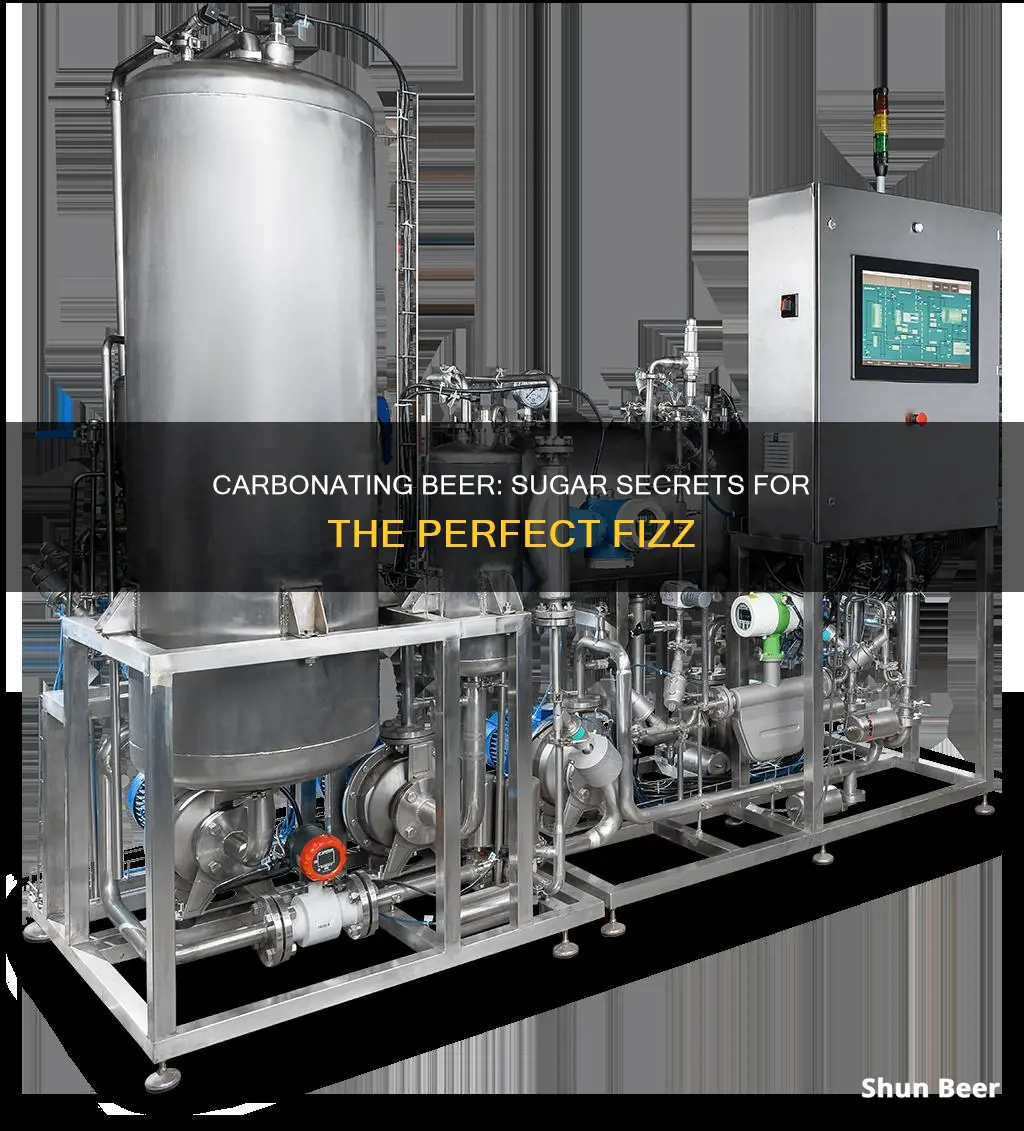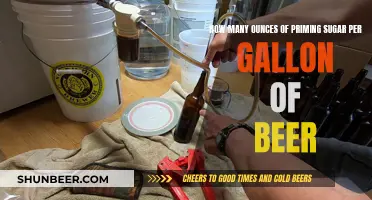
Carbonation is an important feature of beer. It adds mouthfeel, perceived body, and heavily influences the way that hop and malt aromas are delivered to your nose. It is also critical to the beer’s appearance and head retention. Carbonation occurs naturally in beer since yeast produces carbon dioxide along with alcohol when eating sugar. There are two main ways to carbonate your homebrew: priming sugar and force carbonation. This article will focus on the former.
What You'll Learn

Corn sugar or table sugar
Corn sugar and table sugar are two of the most popular types of sugar used to create a priming solution for carbonating beer. They are both simple sugars that are easily digestible by yeast and do not influence the taste of the finished beer.
Corn Sugar
Corn sugar, or dextrose, is the most widely available commercial priming sugar and can be purchased from any homebrew store in pre-packaged amounts suitable for bottle carbonation. It is also very soluble and easy for the yeast to digest. To prepare corn sugar for carbonating beer, simply put it in some warm water and swirl it around until it is dissolved.
The amount of corn sugar you will need depends on the desired level of carbonation and the volume of beer you are carbonating. For low carbonation (dry stout, English ale), use 0.5 ounces of corn sugar per gallon. For medium carbonation (American ales, porter), use 0.9 ounces per gallon. For high carbonation (German weissbier, Belgian blond), use 1.5 ounces per gallon.
Table Sugar
Table sugar, or sucrose, is a low-cost and easily available option for priming sugar. It is a disaccharide, meaning it is a two-cell sugar, while corn sugar is a monosaccharide. This means that yeast will have to work harder to split table sugar, which can result in stressed and weak yeast that produces off-flavours. However, most people's tasting abilities are not refined enough to tell the difference in taste between corn sugar and table sugar.
The amount of table sugar needed for carbonation is different from that of corn sugar, so the amounts cannot be substituted for each other. For every five gallons of beer, the general recommendation is to use 2/3 cup (5.3 ounces or 150 grams) of table sugar.
Cider Beers: Sugar Content and Health Considerations
You may want to see also

How much priming sugar is needed
The amount of priming sugar needed to carbonate beer depends on several factors, including the type of beer, the desired level of carbonation, the volume of beer, the temperature, and the type of sugar used.
Priming sugar is added to beer before bottling to initiate a "re-fermentation" process, where the yeast consumes the sugar to produce carbon dioxide, creating carbonation. The amount of sugar added will determine the level of carbonation in the finished beer.
For corn sugar, the following quantities are recommended for different levels of carbonation:
- 0.5 ounces per gallon for low carbonation (suitable for dry stout or English ale)
- 0.9 ounces per gallon for medium carbonation (ideal for American ales or porter)
- 1.5 ounces per gallon for high carbonation (used for German weissbier or Belgian blond)
Other types of sugar, such as table sugar (sucrose) and dry malt extract (DME), can also be used for priming. However, the quantities required may differ from those of corn sugar.
It is important to note that the temperature of the beer and the volume of beer being carbonated will also impact the amount of priming sugar needed. Colder liquids can hold more carbon dioxide, and the volume of gas is directly related to the level of carbonation.
To ensure accuracy, it is recommended to use a priming sugar calculator, which takes into account various factors to determine the precise amount of sugar required for the desired level of carbonation. These calculators can provide measurements in weight (grams or ounces) rather than volume, as weight is considered a more reliable method for consistent results.
Best Low-Sugar Beers: The Sweetness Spectrum
You may want to see also

The role of carbonation in beer
Carbonation is an important feature of beer. It gives beer its distinct refreshing aspect, adds mouthfeel, perceived body, and heavily influences the way that hop and malt aromas are delivered to your nose. It is also critical to the beer's appearance and head retention.
Carbonation occurs naturally in beer since yeast produces carbon dioxide along with alcohol when it eats sugar. The amount of carbonation depends on the amount of sugar added. When using corn sugar, for example, you would use 0.5 ounces per gallon for low carbonation, 0.9 ounces per gallon for medium carbonation, and 1.5 ounces per gallon for high carbonation.
There are two main ways to carbonate beer: natural and forced carbonation. In both cases, beer and carbon dioxide are sealed in a container under pressure. The beer absorbs the carbon dioxide, giving the beer its fizz.
Natural carbonation results from the fermentation process. Fermentation produces alcohol and carbon dioxide as yeast digests the sugar in the wort. Although most of the carbon dioxide is allowed to escape during fermentation, the brewer will seal the beer in a container when it is almost complete. This is how natural carbonation is used to carbonate beer in holding vessels at the brewery and in casks.
Another way to use natural carbonation is in the bottle. In this case, the beer is allowed to ferment completely and is left unfiltered, leaving active yeast suspended in it. Then, a small amount of sugar is added at bottling time. Once the bottles are sealed, the yeast begins to act on the sugar, releasing carbon dioxide, which is absorbed by the beer.
Forced carbonation, on the other hand, involves pumping carbon dioxide into a sealed container with the beer. It is commonly used for kegs. The beer is allowed to fully ferment, and then carbon dioxide is pumped into the keg after it has been refrigerated. After a few days, the carbon dioxide will be absorbed into the beer, fully carbonating it.
The most common way to carbonate beer is to simply force carbon dioxide into the beer under pressure. This is usually done when the beer is finished fermenting and cold, generally being the final step before the beer is stored and packaged.
Sugar in Beer: What's the Sweet Percentage?
You may want to see also

Different types of sugar for priming
There are several types of sugar that can be used for priming and carbonating beer. The choice of sugar depends on the desired level of carbonation and the flavour profile of the beer. Here are some of the most commonly used sugars for priming:
- Corn Sugar (Dextrose): Corn sugar is a popular choice for priming beer as it is easy for the yeast to digest and it does not alter the flavour of the finished beer. It is also very soluble and widely available in pre-packaged amounts suitable for bottle carbonation. When using corn sugar, the recommended amount for low carbonation is 0.5 ounces per gallon, 0.9 ounces per gallon for medium carbonation, and 1.5 ounces per gallon for high carbonation.
- Table Sugar (Sucrose): Table sugar is a basic and cost-effective option for priming. It is easily available and does not add any flavour to the beer. However, some brewers claim that it produces inconsistent results and may stress the yeast. The measurements for table sugar differ from corn sugar, so adjustments are necessary when substituting.
- Dry Malt Extract (DME): DME is an unfermented wort that has been dried into powder form. It adds flavour and body to the beer and some brewers argue that it produces finer bubbles compared to sugar. However, priming with DME can take longer than sugar, affecting the appearance of the bubbles initially.
- Honey: Honey has been traditionally used as a priming agent and can add unique flavours and aromas to the beer. However, it can be challenging to work with due to its variable density, composition, and viscosity. To calculate the amount of honey needed for priming, it is recommended to determine its specific gravity and compare it to that of a sucrose solution.
- Other Substitutes: Various other sugars can be used as priming substitutes, including demerara sugar, agave nectar, treacle, maple syrup, molasses, and Belgian candi syrup. These options may add unique flavours and aromas to the beer. However, caution is necessary to avoid over-priming and the potential issues that come with it, such as swollen caps and exploding bottles.
Beer and Blood Sugar: How Three Beers Affect You
You may want to see also

Calculating carbonation levels
To calculate carbonation levels, you first need to choose a target carbonation level, expressed in volumes, before you carbonate your beer. If you are unsure where to start, a level of around 2.4-2.6 is typical for an American ale. You also need to take into account the temperature of the beer, the volume, the type of sugar, and the level of carbonation desired.
When using the bottling calculation, you need to enter the temperature of the beer at bottling time, as this is used to calculate the amount of residual CO2 left in the beer from fermentation. For kegging, the calculation is based on the keg storage temperature, which is usually the temperature of your keg refrigerator.
For example, if you fermented an American pale ale at 68 °F (20 °C) and plan to carbonate it with corn sugar, you can calculate the amount of carbonation required from the priming sugar. If you decide you want your carbonation level to be 2.4 volumes of CO2, and you see that you should have 0.85 volumes of CO2 in your beer after fermentation at 68 °F (20 °C), you can subtract 0.85 from 2.4 to get 1.55 volumes of CO2, the amount of carbonation required from the priming sugar.
When using corn sugar, the following quantities are recommended:
- 0.5 ounces per gallon for low carbonation (dry stout, English ale)
- 0.9 ounces per gallon for medium carbonation (American ales, porter)
- 1.5 ounces per gallon for high carbonation (German weissbier, Belgian blond)
Michelob Ultra Beer: Sugar Content and Health
You may want to see also
Frequently asked questions
Carbonation is the process of adding fizz to a beer. It also carries volatile aroma compounds to your nose and activates the trigeminal nerve in your mouth.
The amount of sugar you need depends on the volume of beer you have made, the amount of carbon dioxide already in the beer, and the amount of carbonation you want to add. You can use an online calculator to work out the precise amount of sugar required.
You can use a variety of sugars to carbonate your beer, including corn sugar, table sugar, or dry malt extract (DME).
First, weigh out the amount of sugar you need and put it in a pan with twice that amount of water. Boil the solution for 5 minutes and then allow it to cool. Next, pour the solution into a bottling bucket and siphon the beer from the fermenter into the bucket. Gently stir the mixture for at least 30 seconds.
After adding the sugar, you should store the bottles in a dark area within the temperature range specified in your recipe for around 2-3 weeks.







